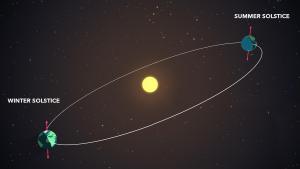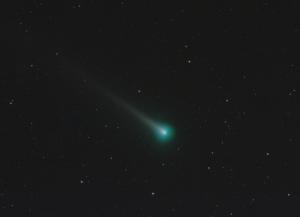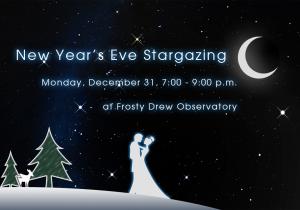Celebration of Space - December 18, 2021
Tomorrow night, Saturday, December 18, 2021 at 11:38 pm the Moon will arrive at the point in its orbit around Earth where it is on the opposite side of the Earth than the Sun. We call this Superior Conjunction, which is also known as the Full Moon. The December full Moon carries the moniker The Full Cold Moon, which may not apply this year yet. But give it a few days, those winter temps are coming. Another name, and probably more appropriate, that the December Moon goes by is the Full Long Night Moon, and in 2021 this is quite the accurate name to use. December has the shortest daytime periods of the year because this is the month that Earth arrives at the Winter Solstice. The closer the Full Moon occurs to the Winter Solstice, the longer the Moon will be above the horizon for that night. Additionally, the Moon orbits Earth inclined 5° to the ecliptic (the path the Sun takes across the sky). If the Moon happens to be close to 5° above the ecliptic during the December full Moon, then the Moon will be up that much longer for Northern Hemisphere sky watchers. This year, the Moon will sit almost 2° above the ecliptic. This will keep the Moon above the horizon for 15 hours and 52 minutes. Additionally, the December Moon will be the highest Full Moon of the year, at 73° above the southern horizon at its highest nightly for our location. So take a moment Saturday night to step outside and welcome the Full Cold Long Night Moon with festive holiday cheer.
On Tuesday, December 21, 2021 at 10:59 am EST, Earth will reach the point in our orbit around the Sun where we are tilted 23.4° away from the Sun in the Northern Hemisphere. This is called the Winter Solstice, and marks the first day of winter in the Northern Hemisphere. On the Winter Solstice, we will experience our shortest daytime period of the year in the Northern Hemisphere. Locations north of the Arctic Circle will have 24 hours of night with corresponding locations south of the Antarctic Circle experiencing 24 hours of daylight. In the Southern Hemisphere the Sun will cross the zenith (directly overhead) along the Tropic of Capricorn, resulting in the Sun crossing the sky 23.4° below Earth’s equator. All that aside, the Winter Solstice brings all the fabulous celebrations we have during this time of the year. It’s a harbinger of the cold long dark ahead as we descend into the winter, but it’s also the point that the days start to get longer as we begin our shift towards the warmer season. So take a moment late Tuesday morning to step outside and notice how low the Sun is in the sky, and welcome the reason for the season as we make our final plunge into holiday bliss and close a busy yet fantastic year at Frosty Drew Observatory and Science Center.
Over the past month, the buzz surrounding Comet C/2021 A1 Leonard has been the big thing in astronomy. It’s the brightest comet of 2021, and has brightened beyond expectations several times. On December 12, 2021, Comet Leonard made its closest approach to Earth, and is now heading towards perihelion (closest approach to the Sun), which will occur on January 3, 2022. When the comet passed Earth, it moved from the pre-dawn morning sky into the early twilight evening sky. Well this past week the comet brightened again, and started showing up clearly in sunset photographs. In Southern New England, we have had some wispy clouds in the western sky after sunset, which has been thwarting our view, but Comet Leonard is still putting on a show. Tonight, December 17, 2021, Comet Leonard will sit about 5° below Venus in the southwest sky. Then tomorrow, December 18, 2021, the comet will be about 6° below Venus in the southwest sky. Even though weather is not looking too promising for Southern New England sky watchers, these are fantastic opportunities to catch a view. Set out for a location with a good view of the SW horizon, and be there shortly after 5:00 pm. Using binoculars or a camera you should be able to get a good view. If you happen to get a pic of the comet, post it to the Visitor Posts section of our Facebook and we’ll share it on our timeline. Good luck!
Regarding next Friday’s Stargazing Nights event at Frosty Drew Observatory and Science Center. Due to the holiday falling on that day, our Astronomy Team will be partaking in many festive revelries. As such, the Frosty Drew facilities will remain closed on Friday, December 24, 2021.
The next time we open will be our New Years Even Stargazing event on Friday, December 31, 2021. The Town of Charlestown will host its annual New Year’s Eve Bonfire event from 5:00 pm – 6:00 pm. After which, the Frosty Drew Observatory and Science Center will open from 7:00 pm – 9:00 pm to celebrate the end of the year. With no Moon present during the evening we will be focused on the Orion Nebula, Hubble's Variable Nebula, The Crab Nebula supernova remnant, NGC 2392 the formation of a white dwarf, and more. So put the cosmos on your list of New Year’s celebrations and kick off your night of frivolities with a blazing fire and thousands of stars.
Have a Happy Winter Solstice and a fantastic Holiday, in whatever way you celebrate, from all the astro-geeks at Frosty Drew!
- Author:
- Scott MacNeill
- Entry Date:
- Dec 17, 2021
- Published Under:
- Scott MacNeill's Columns





